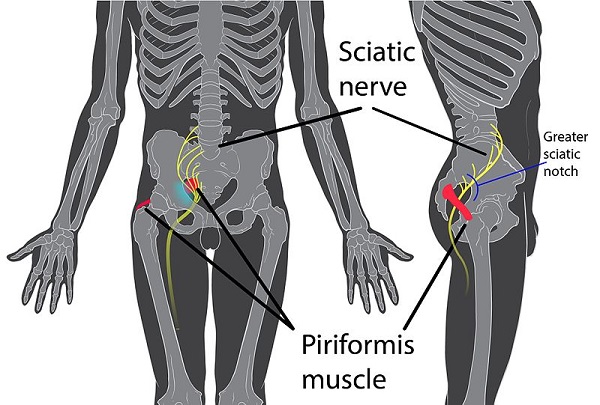Positive Health Online
Your Country

Top Tips for Combating Sciatica Naturally
listed in back pain, originally published in issue 247 - July 2018
Sciatica is defined as pain in either one or both legs with possible tingling, numbness or weakness caused by the pinching of the sciatic nerve along its pathways.
The sciatic nerve is the largest nerve in the body, supplying both sensation and motor function to the legs. It is made up over several individual nerves that branch off from the spinal cord through our vertebrae.
It is rare for sciatica to occur before the age of 20 due to the suppleness of the structures that surround the sciatic nerve. As we age, those structures start to degenerate or become tight, leaving the nerve vulnerable to being pinched along its pathway. Researchers have estimated sciatica affects up to 43% of the population at some point.
There are a variety of symptoms associated with sciatica:
- Pain that is constant on only one side of the buttock or back of the leg;
- Pain that is worse when sitting;
- Numbness, tingling, burning or weakness in the buttocks or legs;
- The symptoms can be constant or develop when moving;
- A sharp pain that may make it difficult to stand up or walk;
- Sharp shooting pain that travels down the leg in a line, often into the foot and toes.
Research has shown that individuals who are obese, overweight or who smoke are at more risk of developing sciatica. Smoking has shown to dehydrate and degenerate spinal discs, leaving them vulnerable to bulging against a nerve. Many people who suffer from sciatica often get better within a few weeks on its own; with others, it may take many months. It all depends on what has caused it. It’s important to identify the cause as early as possible as limping to avoid the pain can often trigger a separate set of symptoms.

7 Most Common Causes of Sciatica
Lumbar Herniated Disc
Herniated discs occur when the gel-like material inside the disc pushes against the outer coating, causing it to bulge. This bulge can then push against the nerve that runs alongside it.
Additional terms used to refer to a herniated disc are slipped disc, prolapsed disc, bulging disc or protruding disc. The most common symptoms of a lumbar herniated disc is sciatica.
Degenerative Disc Disease
Discs, alongside cartilage in the body, don’t have a blood supply. This means a disc’s ability to repair and regenerate isn’t as efficient as a muscles ability for example. As we age, the volume of fluid in the disc lessens, weakening the structure, leaving it vulnerable to bulging out against a nerve. This can then cause sciatic type pain if the disc that is bulging against the nerve is in the bottom third of the spine.
Lumbar Spinal Stenosis
Stenosis occurs when the space between the spinal joints are narrowed. You have nerves that travel next to this space, so they can often become irritated as the space between the joints lessen. It often develops over time as a result of degeneration in the spinal joints as we age, and is common in most people over the age of 60.
Piriformis Syndrome
One of the most common causes of sciatica is when the sciatic nerve becomes pinched by the piriformis muscle. The muscle itself is one of the deep buttock muscles and in 30% of the population, the nerve runs directly through it, leaving these individuals more vulnerable to it pinching. Humans weren’t designed to sit for as long as we do in the 21st century with the growth of deskbound jobs. This plays a role in the development of tension in the piriformis. The good thing is that it is one of the easiest forms of sciatica to resolve with alternative treatments.
Sacroiliac Joint Dysfunction
When the sacroiliac joint is irritated it has the ability to irritate the lowest lumbar nerve as it runs alongside the joint, causing debilitating sciatic type pain as the joint is moved with minor movements such as walking.
Pregnancy
The weight of the baby can cause many of the muscles that surround the sciatic nerve to tighten up around it, causing symptoms of sciatica. Also, during the third trimester of pregnancy, a hormone called relaxin is released. This hormone does what it says in the name, relaxes the ligaments in the pelvis to allow for the baby to travel through easily during labour. The relaxing of these ligaments can often cause the pelvis to misalign, which can pinch some of the nerves that run through that area.
Muscles Strain
If any of the muscles along the pathway of the sciatic nerve suffer a strain, if it isn’t treated properly then it can cause scar tissue over that strain. This scar tissue can potentially put pressure on the sciatic nerve.

Conventional Treatment for Sciatica
Prescription or over-the-counter medications can often be effective at reducing the symptoms of sciatica. Nonsteroidal anti-inflammatory drugs (NSAIDS) such as ibuprofen can help if the sciatica is due to any inflammation pressing against the nerve. If the pain is due to tension in the muscles tightening around the nerve, then muscle relaxants such a diazepam can help. These aren’t long-term solutions though, and won’t address the root cause of your symptoms or help prevent them from coming back. Long-term use of these types of medication can have negative effects on the health of your stomach and liver.
To help reduce the symptoms naturally and prevent them from returning, a more structured treatment approach needs to be adopted.
Natural Sciatica Treatment
Heat/Ice
Heat and ice can help for both acute and chronic cases of sciatica. If the sciatica is as a result of an acute injury, straining a muscle for example, then you can use a procedure called contrast bathing. This involves placing ice or a cold compress over the area for 10 minutes and then immediately after, placing heat over the area for 10 minutes. This can be repeated twice an hour if needed. If the sciatica is as a result of piriformis syndrome then sitting on a hot water bottle for 20 minutes under your buttock can help.
Osteopathy
Osteopathy is a system of alternative medicine that helps to both identify and address the root cause of an individual’s sciatica. Several orthopaedics tests will be used to find out where the sciatic nerve is being pinched; then a combination of massage, stretching and gentle manipulation is used to take the pressure off the nerve. Several stretches will also be prescribed to help sustain the results and prevent the symptoms from returning.
Acupuncture
If the cause of an individual’s sciatica is the result of tension in the leg muscles tightening up around the nerve, then acupuncture can be effective at helping reduce this tension. Hair-thin needles (which are usually not felt) are inserted into the affected muscles.
Massage Therapy
Again, if an individual’s sciatica is caused by tight muscles around the sciatica nerve then massage therapy can be an effective way of releasing those muscles, creating an environment for the sciatic nerve to operate without any irritation.
Osteopathy, Acupuncture and Massage have all been approved by the NICE Guidelines (National Institute for Health and Care Excellence). Both NHS and private doctors in the UK use these guidelines to inform them of appropriate treatments.
Intervertebral Differential Dynamics (IDD) Therapy
Intervertebral Differential Dynamics (IDD) Therapy is a non-surgical spinal decompression treatment. IDD Therapy uses computer-controlled pulling forces delivered by SPINA medical devices to gently distract (draw apart) targeted segments of the spine in order to take pressure off specific discs and nerves whilst at the same time, gently stretching tight muscles and stiff ligaments. If the symptoms of sciatica are being caused by a nerve being pinched in the lower back by a joint or disc and there has been little relief achieved with other treatments, then IDD Therapy can be a good option. Overall, the evidence shows that IDD Therapy to be as effective or more effective than manual therapy and exercise and more effective than traditional traction.
McClure et al show that 92% of 129 patients considered surgical candidates had a greater than 50% reduction in pain with IDD Therapy,[1] Schimmel et al show IDD Therapy to be no different from sham treatment[2] whilst Shealy et al show pain relief at the end of treatment and continuous pain reduction one year after completion of treatment.[3]
The above description of IDD Therapy has been taken from the following website: www.iddtherapy.co.uk.
References
1. McClure D and Farris B, Intervertebral Differential Dynamics Therapy – A New Direction for the Initial Treatment of Low Back Pain. European Musculoskeletal Review https://bit.ly/2IDXH42 2006.
2. Schimmel JJ, de Kleuver M, Horsting PP, Spruit M, Jacobs WC, van Limbeek J. No effect of traction in patients with low back pain: a single centre, single blind, randomized controlled trial of Intervertebral Differential Dynamics Therapy. Eurospine Journal (12): 1843-1850. Dec 18 2009. https://bit.ly/2Imix4J
3. C. Norman Shealy, MD, PhD, Nirman Koladia, MD, and Merrill M. Wesemann, Long-Term Effect Analysis of IDD Therapy in Low Back Pain: A Retrospective Clinical Pilot Study. American Journal of Pain Management Vol. 15 No. 3 July 2005. https://bit.ly/2L28Nyf
Comments:
-
No Article Comments available